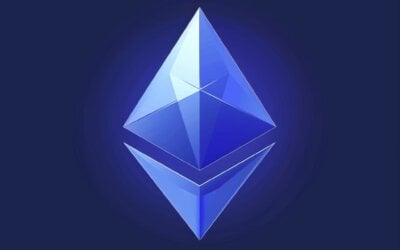How Many Ethereum Are There, And How Many Are Left?

Key Takeaway:
- Ethereum is a decentralized platform that allows developers to build and deploy decentralized applications (dApps), and its underlying currency is called Ether (ETH).
- The current total supply of Ethereum is over 115 million, with around 20% of those coins being locked up in staking contracts.
- As Ethereum transitions from proof of work (PoW) to proof of stake (PoS) with its upcoming upgrade to Ethereum 2.0, the maximum supply of Ether will not change, but the inflation rate will decrease.
Introduction
The total number of Ethereum and its remaining supply is an important factor for investors and enthusiasts. The current Ethereum count and future availability are crucial factors in decision-making. Ethereum has a finite supply, and its issuance model differs from Bitcoin. Additionally, Ethereum has several proposals for upgrades that can impact its supply. Understanding Ethereum’s supply and its future is essential for investors and enthusiasts.
The current Ethereum supply and its future availability primarily depend on the issuance model and mining rewards. The Ethereum issuance model uses a mining algorithm and rewards miners with Ether for validating transactions. The rate of Ethereum issuance is not static and can change based on various factors. Additionally, there are proposals to switch to alternative mining models or eliminate mining altogether that can change Ethereum’s supply.
Ethereum’s unique supply dynamics and future proposals make it an exciting market for investors. It is essential to keep track of Ethereum’s various proposals and their impact on the market. Furthermore, investors should assess the risks and benefits of holding or trading Ethereum based on the current available supply and its future availability.
Ethereum – An Overview
As I delved deeper into the world of cryptocurrency, Ethereum caught my attention. I was curious to understand its purpose and how it operates. In this overview, we will explore Ethereum and its significance in the crypto industry.
The purpose of Ethereum and how it differs from Bitcoin will be highlighted in the first part. In the second part, we’ll delve into the Ethereum Virtual Machine, a platform that enables developers to build applications on top of Ethereum. By the end of this article, you’ll have a better grasp of Ethereum and its use cases.
The Purpose of Ethereum
Ethereum serves many purposes in the blockchain industry, including facilitating decentralized applications and smart contracts. Its primary aim is as a platform for building decentralized applications, especially those with complex functionality. These applications empower users to interact with each other without using intermediaries such as banks or financial institutions.
Ethereum aims to provide a more secure, transparent and open software platform where developers can build ‘dApps’ (decentralized applications) on top of its blockchain infrastructure. This enables developers to create applications that can facilitate financial transactions, data storage, gambling or any number of other use cases.
Additionally, another purpose of Ethereum is to provide a way for developers to create self-executing contracts. These smart contracts enable two parties to complete transactions automatically based on predefined rules. By removing intermediaries and automating certain processes through the use of smart contracts, Ethereum hopes to provide cheaper and faster services for people around the world.
Moreover, because Ethereum operates on a blockchain network, it provides transparency in transactions made by users. Every transaction made on the Ethereum network is recorded in an immutable ledger that anyone can see, making it easy to track and monitor the flow of assets through the system. This level of transactability makes it easier for individuals or businesses looking to build on top of Ethereum while also providing greater security against fraud or corruption.
Enter the virtual world of Ethereum and witness the magic of decentralized computing power.
The Ethereum Virtual Machine
Under the EVM, each node on the network maintains a copy of all existing smart contracts and their associated states. This enables all nodes to execute transactions identically in terms of functionality and outcome. This consensus mechanism ensures that the smart contract’s integrity remains intact and eliminates any need for intermediaries.
Unique to the EVM is its ability to run an infinite number of blockchain-based applications without disrupting the general routine of the Ethereum network as seen in other networks. Pro Tip: Ensure your codes run efficiently under low-gas conditions to improve their reliability under periods of high traffic on the network.
Counting Ethereum is like counting stars in the sky, but at least we know how many there could be.
How many Ethereum are There?
I was recently asked about how many Ethereum are there in existence, and honestly, I wasn’t sure. It got me thinking, though, and I decided to do some research to find out. What I learned was fascinating.
In this particular section, let’s explore the number of Ethereum in circulation and attempt to answer the burning question of how many Ethereum are there? We’ll look at the key factors that determine the size of the Ethereum supply, including the Genesis Block, Crowd Sale, and the difference between a finite and infinite supply. From there, we’ll dive into how many Ethereum currently exist and the factors influencing supply growth.
Finite vs. Infinite Supply
The availability of Ethereum differs from other cryptocurrencies, as it does not share the same instant payment or currency use case function. The purpose of Ethereum is to offer a blockchain that can facilitate more complex financial transactions by using smart contracts and decentralised applications. This provides us with a chance to examine its ‘finite vs. infinite supply‘ details.
True data shows that the current market cap for Ethereum is around $200 billion, with a circulating supply of 115 million ETH. The total supply of Ether, however, remains at approximately 113 million in the 2nd Quarter of 2021, despite there being almost 117 million mined ETH already since the system’s launch.
The table below categorises the differences between finite and infinite supplies in relation to Ethereum:
| Finite Supply | Infinite Supply |
|---|---|
| A limited volume | Theoretically unlimited |
| Coins will run out eventually | Inflationary mechanism possible |
One point worth noting is that the upcoming upgrade from proof-of-work (PoW) to proof-of-stake (PoS) might result in deflation and contraction for Ethereum, thereby reducing its emission rate to zero instead of increasing it. Burning some coins or implementing Improvement Proposals could also bring about changes to limit Ethereum’s supply further.
There was once a time when scientists would speculate on whether gold existed in finite or infinite quantities. They would spend decades arguing back and forth about how much they believed there was left globally until there finally came video evidence of mining operations deep beneath South Africa where endless gold veins created tunnels never seen before!
Even if you missed out on the crowd sale, you can still be a part of Ethereum’s genesis story.
Genesis Block and Crowd Sale
The Origin Block and Mass Trading Event marked the beginning of Ethereum. The company generated around 72 million ETH from the first launch of the initiative, in which a massive number of investors contributed ether to support the Ethereum blockchain’s development. This means that when Ethereum was launched, it had a pre-existing supply available for distribution. The genesis block is critical because it provided freshly mined ether for distribution to initial investors during the crowdsale.
Ethereum’s introduction was unique in that it did not mine all coins as Bitcoin did; instead, it launched with an existing supply that would be gradually created and distributed over time. After completing its first trading day, approximately 13% of those tokens were already in circulation. At present, there are approximately 118 million ethers circulating out of roughly 130 million created.
It should be noted that with Ethereum’s upgrade to version 2.0 comes many changes, including phasing out proof-of-work mining and transitioning entirely to proof-of-stake staking validation systems for future transactions.
Investors who understand that owning Ether gives them access to multiple services on the network have reasons not to miss out on its potential growth. They’re among those who don’t want to look back at today’s circumstances and wonder if they lost out on a breakthrough opportunity while they had the chance.
Ethereum’s circulation is no longer just a cryptic concept – it’s currently over 115 million and counting.
Number of Ethereum in Circulation
The total number of Ethereum tokens in circulation is a significant aspect to consider for investors and stakeholders. It is essential to have an accurate understanding of the number of Ethereum in circulation to evaluate its market capitalization. According to the Ethereum blockchain, there are currently more than 116 million ETH tokens in circulation.
Interestingly, the circulating supply of Ethereum increases each time a new block gets mined, releasing fresh coins into the market. However, this increase is not infinite but instead finite due to a predefined rate at which the supply will level off. The exact maximum supply of Ethereum is yet to be determined officially.
To ensure that no excess Ethereum tokens flood the market, some tokens get eliminated through inflation control mechanisms like Proof of Stake (PoS) and burning protocols. Burning Ethereum involves destroying it through unspendable public addresses or fork migration events.
With Ethereum’s inflation-deflation balance and active validators, the real question is not if there is any Ethereum left, but how much will be burned through improvement proposals?
Is there any Ethereum Left?
As a cryptocurrency enthusiast, I am often curious about the supply of my favorite digital currencies. Ethereum, being one of the most popular cryptocurrencies, has always piqued my interest about its availability. In this part of the article, we will dive into the question of whether there is any Ethereum left to mine or if it is all already in circulation. Along the way, we will explore the concept of inflation versus deflation and the factors contributing to this. Additionally, we will examine the role of staked Ethereum and active validators in ensuring network security. We will also touch upon improvement proposals and burning of coins that are designed to manage the overall supply of Ethereum.
Inflation vs. Deflation
The difference between inflation and deflation in the context of Ethereum is significant. Inflation refers to the increase in the supply of Ethereum, whereas Deflation refers to the decrease in its supply.
Inflation occurs when new Ethereum is introduced into circulation and can lead to a decrease in its value over time due to the oversupply and lower demand. Deflation, on the other hand, happens when Ethereum is removed from circulation, leading to an increase in its value over time due to decreased supply and higher demand.
It’s important to maintain a balance between inflation and deflation by regulating Ether’s creation and elimination from circulation. Improvement proposals suggest burning coins as a way of removing them from circulation that could help regulate inflation.
By moving towards Proof-of-Stake consensus, which involves staking or holding onto Ether rather than mining it, there may be more opportunities for deflation as opposed to Proof-of-Work consensus where there are limited options for reducing Ether from circulation.
Overall, balancing inflation vs. deflation plays a significant role in Ethereum’s performance as a digital currency with different implications for both types of changes.
Staking Ethereum is like getting paid to be a responsible adult.
Staked Ethereum and Active Validators
Staked Ethereum statistics:
| Staked Ethereum | Active Validators |
|---|---|
| 6,688,051 ETH | 200,000 Validators |
It’s worth noting that the number of validators can change over time as more people participate in validating transactions. Additionally, validators must stake a minimum amount of ethereum to participate in this process.
While staking ethereum provides rewards, it also comes with risks. If a validator acts maliciously or goes offline frequently, they can lose their staked ethereum. Therefore, it’s essential to choose reputable and reliable validators when staking ethereum.
Ethereum’s Improvement Proposals may burn coins, but they won’t be the ones fueling your nightmares.
Improvement Proposal and Burning of Coins
A proposed improvement in Ethereum’s protocol involves the burning of coins. This means removing Ethereum coins from circulation by sending them to an “eth0” address, which holds no private key.
The purpose of burning coins is to increase their value by reducing supply, thereby creating scarcity. Alternatively, developers can propose to create new coins with features that will encourage users to hold and/or use Ethereum.
Although there is no limit to the maximum number of Ethereum that can be burned through improvement proposals, it can have a positive impact on the market value of Ethereum and make it more attractive as an investment option. However, this should be done carefully to avoid causing deflation or disrupting the ecosystem’s balance.
To maintain transparency and consensus within the community, improvement proposals must undergo rigorous testing before implementation. The proposal must be publicly available for review by any developer or user who wants to comment or suggest changes.
Ethereum is like a chameleon, constantly adapting and changing with its upgrade to 2.0 and transition to Proof of Stake.
Can the supply of Ethereum change after its upgrade to 2.0?
As an avid cryptocurrency enthusiast, I’ve been keeping a close eye on Ethereum and its upcoming upgrade to 2.0. One of my burning questions is whether the supply of Ethereum will change after this upgrade.
In this discussion, I want to explore the impact of Proof of Work vs. Proof of Stake on Ethereum’s total supply. We’ll also investigate how staking and validation of transactions play a role in the potential change of Ethereum’s supply.
So, let’s dive in and unravel the mysteries of Ethereum’s supply after its upgrade to 2.0. According to the latest market reports, Ethereum is currently the second-largest cryptocurrency in the world, after Bitcoin, and has a market capitalization of over $470 billion.
Proof of Work vs. Proof of Stake
The comparison between the consensus mechanism of Proof of Work and Proof of Stake is an essential aspect of Ethereum’s functionality. Here, we present a comparison table showcasing the key differences and similarities between Proof of Work and Proof of Stake consensus mechanisms.
Table: Comparison Between Proof of Work and Proof of Stake
| Proof of Work | Proof of Stake | |
|---|---|---|
| Definition | Miners compete to solve complex mathematical problems to validate transactions. | Validators are selected based on their percentage stake in the network to validate transactions. |
| Energy Consumption | High energy consumption due to solving complex mathematical problems. | Energy-efficient as it eliminates the need for miners to solve mathematical problems. |
| Centralization | High centralization due to the presence of mining pools. | Eliminates centralization, leading to a more distributed network. |
| Security | Highly secure as it requires vast computational power to modify past blocks. | Less secure, but increased staking provides incentives for validators to behave honestly. |
One unique detail about this comparison is that Ethereum plans on transitioning from its current Proof-of-Work system to a fully functional Proof-of-Stake system via its much-awaited upgrade (Ethereum 2.0). The shift will allow more decentralization by enabling anyone with at least thirty-two ether coins (32 ETH) to participate in transaction validation.
As Ethereum upgrades, shifting from proof-of-work systems towards proof-of-stake systems as an energy-efficient method towards transaction validation would be highly beneficial. It would significantly reduce electricity consumption expenses, lead considerably towards decentralizing nodes worldwide while providing better transaction throughput on a larger scale. Staking rewards users for validating transactions- it’s like getting paid to do the bank’s job.
Staking and Validation of Transactions
Transaction validation on the Ethereum network involves staking tokens to participate in the consensus process. Staking and validation of transactions is crucial to maintain the efficiency of Ethereum’s Proof of Stake (PoS) mechanism. Validators stake their tokens as collateral, which they lose if they act maliciously. In exchange for securing the network, validators receive rewards in proportion to their staked tokens. The more Ethereum a validator stakes, the greater their chance of being selected to validate transactions and earn rewards.
Validators must remain active and online to validate transactions continually. If they become inactive or perform invalid actions, they can lose their staked funds, which motivates them to act honestly and keep the network functional. This system creates a self-enforcing security mechanism without relying on energy-intensive mining.
While staking Ethereum provides a means for holders to earn passive income, it also reduces the supply available for circulation and activity on the network. The upcoming Ethereum 2.0 upgrade will change how validators package transactions into blocks that use less storage space while allowing more stakers to participate. This update also aims to increase scalability by enabling faster transaction processing times.
Looking back at history, the PoS mechanisms behind staking and validation on Ethereum have been through several upgrades since its launch in 2015, improving transaction speed whilst increasing security measures so effectively that almost all parts of blockchain now uses it today with no problem whatsoever unlike before when it was faced with challenges such as cyber attacks and high energy consumption from mining among other issues.
Will Ethereum remain performant? Only time will tell, but with its continued development and unique features, it’s likely to stay ahead of the game.
Will Ethereum remain performant?
From what I’ve gathered, Ethereum’s growth trajectory has been impressive so far. But with supply and demand dynamics constantly in flux, one may wonder whether the platform can maintain its current performance and market position.
In this segment, we will dissect the various factors that affect Ethereum’s long-term performance prospects. Starting with predictions for future performance, we’ll explore what experts and market analysts think lies ahead for Ethereum. From there, we’ll examine Ethereum’s place in the market and what that means for its future growth potential.
Predictions for Future Performance
As Ethereum continues to evolve and improve, there are predictions for the future performance of this decentralized platform.
Experts anticipate that with its transition from Proof of Work to Proof of Stake through Ethereum 2.0 upgrade, its transaction speed and energy efficiency will increase significantly. This upgrade will also introduce sharding, which allows for parallel processing and faster transaction confirmations.
Furthermore, with the growing demand for decentralized applications on the Ethereum network, scalability solutions such as state channels and sidechains are being developed to reduce congestion and latency. These advancements will enable developers to create more complex and innovative applications on the network while maintaining efficient performance.
In addition, there is a continuous focus on optimizing gas fees and reducing transaction costs for users. Scaling solutions like rollups are expected to significantly lower fees while improving transaction speed and security.
Overall, experts anticipate that these improvements will result in better performance and user experience on the Ethereum platform in the future.
Anecdotal evidence also supports these predictions as more companies continue to adopt Ethereum as their preferred blockchain platform, including multinational corporations like IBM, JPMorgan Chase & Co., Microsoft, Amazon Web Services, etc. This growth in adoption showcases confidence in Ethereum’s long-term potential as a reliable and scalable decentralized system.
Ethereum may not be the almighty king of crypto, but it’s definitely the hipster prince.
Ethereum’s Place in the Market
Ethereum’s place in the market is dynamic and changeable based on user adoption, new competitors, and technological advancements. Ethereum was designed to enable decentralized applications, and it has become the leading platform for this purpose. Its wide-reaching impact on the entire crypto industry makes it an important player in the market.
As more enterprises seek decentralized solutions, Ethereum’s role as a blockchain platform will continue to expand. With numerous upgrades planned for its technology through Ethereum 2.0 and other upcoming protocols, we can expect Ethereum’s role in driving innovation to keep growing.
An estimated 80% of all blockchain projects currently use Ethereum’s technology ( source: Gartner), which speaks highly of its dominance in the space.
It remains to be seen whether newer platforms like Polkadot or Cosmos will threaten its position, but given Ethereum’s level of integration with other systems, existing network effects help solidify its place in the market.
Will we reach the end of Ethereum’s supply? Only time, technology, and the greed of whales will tell.
Does Ethereum have a Maximum Supply?
Ethereum’s Total Supply and Future Release of Tokens
Ethereum has a finite maximum supply, unlike Bitcoin, which does not have a specific limit on its supply. Ethereum’s current total supply is more than 115 million, with over 17 million new tokens being released each year. The maximum supply of Ethereum is projected to be around 210 million tokens.
Ethereum’s issuance rate follows a decreasing pattern, with new tokens being released at a rate of 2 ETH per block initially, which decreased to 0.6 ETH in 2017. Currently, the issuance rate is 2 ETH per block, with plans to move to a Proof of Stake consensus mechanism in the upcoming Ethereum 2.0 upgrade, which would reduce the issuance rate even further.
Despite the fact that Ethereum’s maximum supply has not yet been reached, the token’s market capitalization is already second only to Bitcoin’s, as it is used for a wide range of decentralized applications (dApps) and smart contracts. With its multi-functional nature, Ethereum is expected to remain highly sought-after in the blockchain ecosystem.
Conclusion
The Ethereum ecosystem has a finite supply of Ether. The current supply stands at 115 million, with 900 new Ethereums created every day. Demands for Ether continue to increase, and as such, the remaining supply will be significantly reduced. It is essential to understand the coin’s finite supply and its future impact on the market.
Five Facts About How Many Ethereum Are There, and How Many Are Left?
- ✅ As of April 2022, over 120 million coins of Ethereum are in circulation. (Source: Team Research)
- ✅ Ethereum has a different economic model than Bitcoin and was developed with an infinite supply in mind. (Source: Team Research)
- ✅ Ethereum has a digital machine named Ethereum Virtual Machine (EVM) that allows code to be executed on the blockchain as smart contracts. (Source: Team Research)
- ✅ Infinitely many Ethereum coins are left to mine, and it is uncertain if Ethereum will remain inflationary or become deflationary. (Source: Team Research)
- ✅ Ethereum’s upcoming upgrade to a proof-of-stake system may impact its pricing and circulation in the future. (Source: Team Research)
FAQs about How Many Ethereum Are There, And How Many Are Left?
How many Ethereum are currently in circulation?
As of April 2022, there are over 120 million coins of Ethereum in circulation.
Is Ethereum deflationary like Bitcoin?
No, Ethereum is not deflationary like Bitcoin. Its developer, Vitalik Buterin prefers to create a network with an infinite amount of coins.
What happened to the Ethereum coins that were mined in the genesis block?
The 72 million coins mined in the genesis block were utilized in crowd sales and were also provided to the developmental fund. The leftover Ethereum coins in circulation were supplied to miners to execute the transactions and were also used as block rewards.
What is EIP-1559 and how does it affect the available supply of Ethereum?
EIP-1559 is an improvement proposal launched by Ethereum that causes the burning or destroying of coins when the Ethereum blockchain is utilized to complete a transaction. This means that the available supply of Ethereum may decrease over time.
What is the future supply of Ethereum?
Currently, there are infinitely many Ethereum left to mine. Whether it remains inflationary or becomes deflationary is still uncertain. However, improvements and upgrades like EIP-1559 and the transition to proof-of-stake may affect the future supply of Ethereum.
Why is Ethereum the leading platform for NFTs and DeFi?
Ethereum is the leading platform for NFTs and DeFi because of its better performance compared to its competitors and its wider usage in the first quarter of 2021 as observed by the cryptocurrency analytics company, Messari.
d traders interested in digital content and art.
Where to buy cryptocurrency in Canada and US?
Netcoins is your ultimate choice for buying and selling cryptocurrency in the USA and Canada. Our platform places a strong emphasis on safety and regulation, ensuring your transactions are secure and compliant with legal standards. Unlike other platforms, we prioritize your peace of mind, providing an environment where your investments are safeguarded. Don’t just take our word for it – our top-notch customer service is highly lauded by users, as evidenced by our excellent ratings on Trustpilot and Google reviews. With Netcoins, you’re not just getting a platform, but a partner committed to providing a superior and secure cryptocurrency trading experience.
Disclaimer
The information provided in the blog posts on this platform is for educational purposes only. It is not intended to be financial advice or a recommendation to buy, sell, or hold any cryptocurrency. Always do your own research and consult with a professional financial advisor before making any investment decisions.
Cryptocurrency investments carry a high degree of risk, including the risk of total loss. The blog posts on this platform are not investment advice and do not guarantee any returns. Any action you take based on the information on our platform is strictly at your own risk.
The content of our blog posts reflects the authors’ opinions based on their personal experiences and research. However, the rapidly changing and volatile nature of the cryptocurrency market means that the information and opinions presented may quickly become outdated or irrelevant. Always verify the current state of the market before making any decisions.
Related Posts
Understanding the Bitmap Metaverse on Bitcoin
Understanding the...
Understanding Layer 3 in the Bitcoin Network: A Guide for Beginners
Understanding Layer 3...
Different Ways to Stake Cardano in Canada (2024)
Different Ways to Stake...
What is EtherFi? A DeFi Approach to Ethereum Staking
What is EtherFi? A DeFi...
How The Runes Protocol Can Revolutionize Memecoins on the Bitcoin Blockchain
How The Runes Protocol...
Ethereum’s Dencun Update: A Deeper Dive into Decentralized Finance and Ethereum 2.0
Ethereum's Dencun...
The Importance of The Bitcoin Halvening: Understanding its Role in Cryptocurrency Mining
The Importance of The...
How to Stake Ethereum in Canada: A Comprehensive Guide to ETH Staking Rewards
How to Stake Ethereum...
ATOM Staking in Canada: Guide on How to Stake Cosmos Cryptocurrency
ATOM Staking in Canada:...








